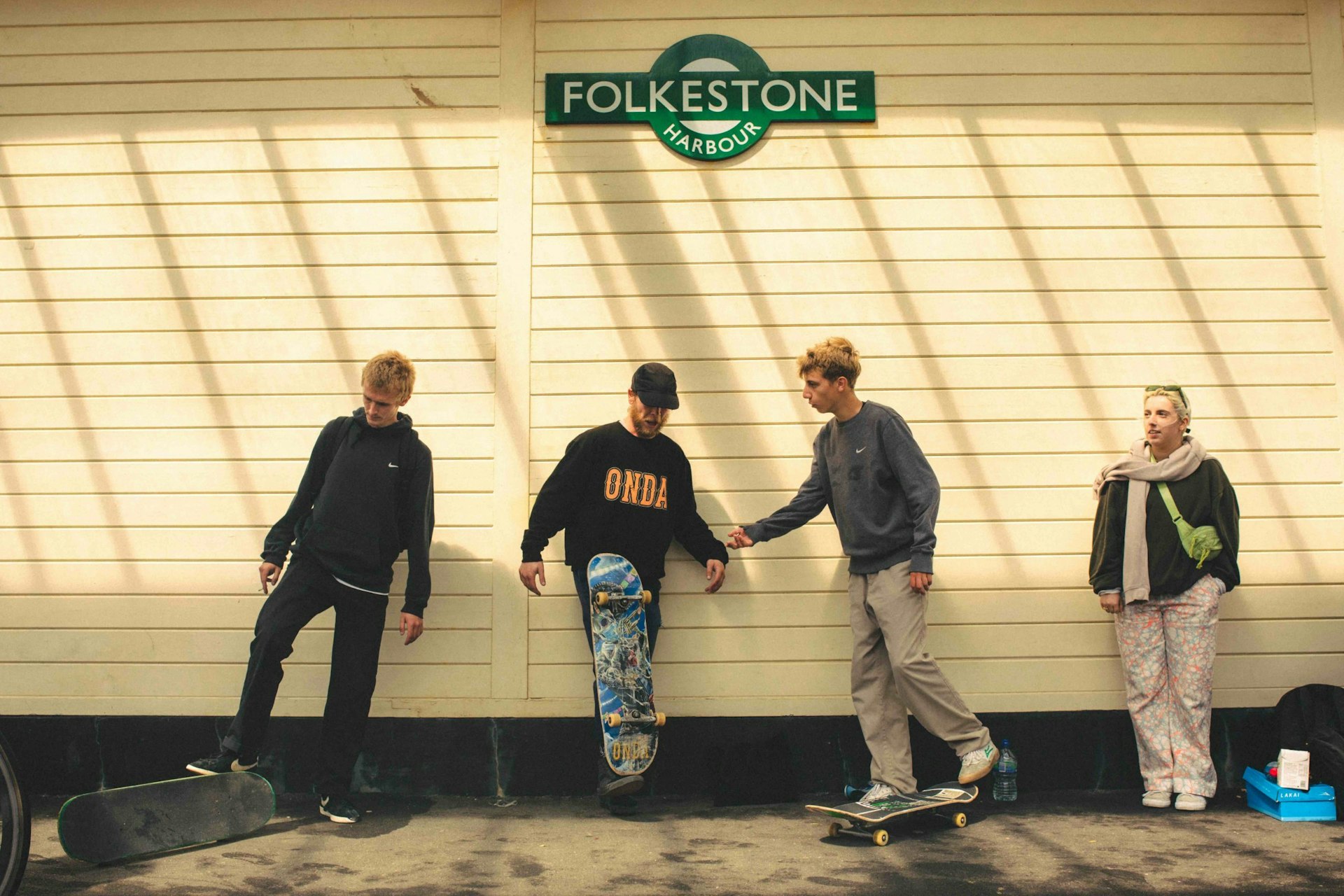
Folkestone is changing – and its skateboarders aren’t happy
- Text by Peter Yeung
- Photography by Theo McInnes
A version of this story appears in Huck Issue 76. Get your copy now, or subscribe to make sure you never miss another issue.
For a fleeting moment, Folkestone seems every inch Britain’s response to the fabled resorts of the Mediterranean. The sea reclines flat on its back, beach pebbles bathe in the sun, and the beguiling chalk cliffs snooze along the horizon.
Then, suddenly, the rains return, thundering down violently. The waves swell and churn. Out of nowhere, a skinny kid with a skateboard sprints into view, screams at the top of his voice, and rides full-tilt over a ramp, contorting his limbs wildly mid-flight, before sketchily landing the kickflip.
Others soon swarm out of the woodwork. One lands a slick railslide. Another bails painfully onto his back. A third snaps his board in two after launching high into the air. But they keep coming. Hundreds of black t-shirts, beanies and baggy jeans: it’s like a scene from a zombie movie if the apocalyptic swarm was made up of gnarly skateboarders.
“I’ve been skating here since I was a kid,” says Joshua Lee, leaning both his tattooed arms against a metal fence at the edge of the pop-up event at Folkestone’s harbour. “It wasn’t always like this. I can guarantee you that.”
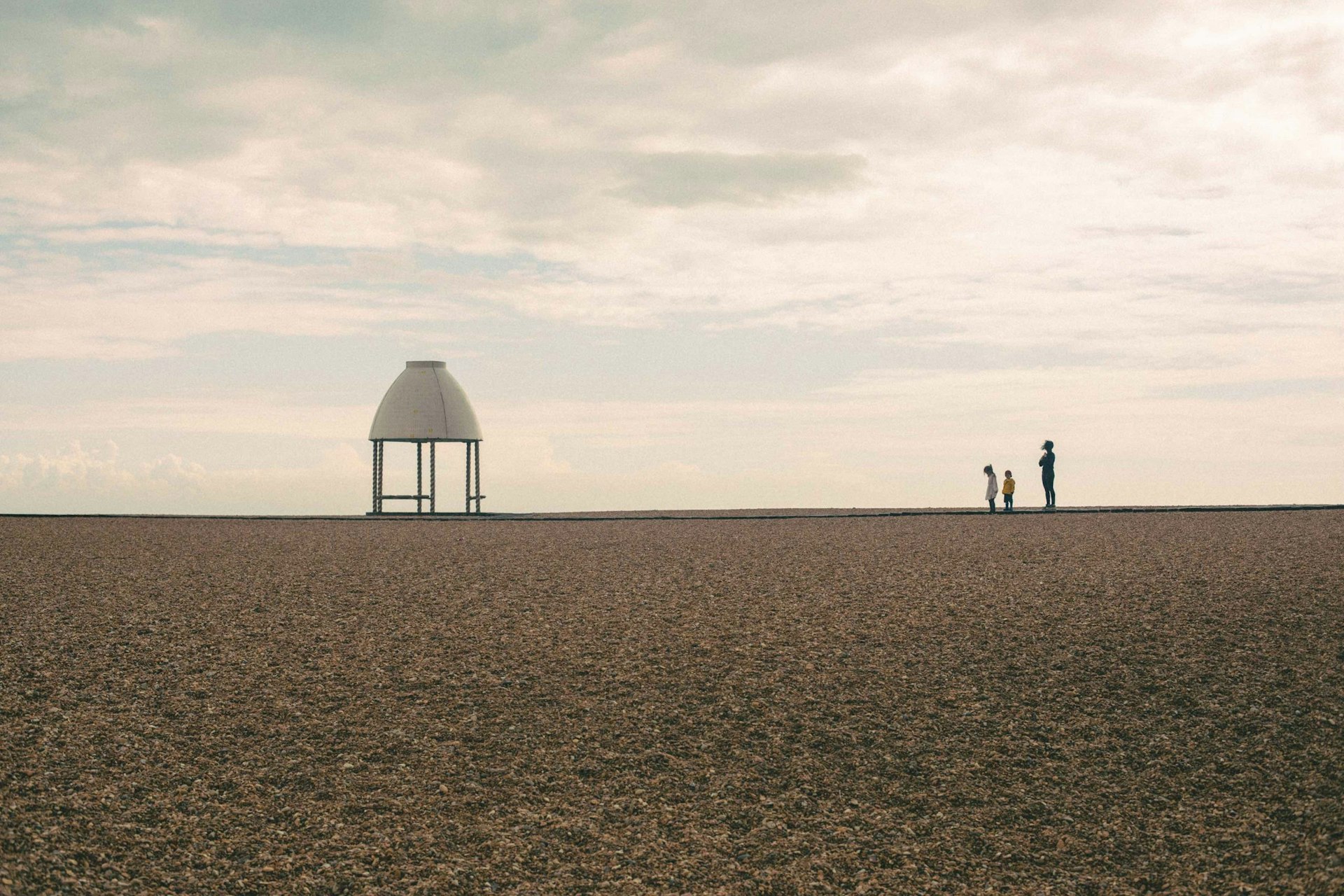 All around, energy pulses through the air – not just because of the punk tracks pounding out the stacks of speakers, or the thunderous clouds overhead. The day’s Red Bull-sponsored event, which has brought with it all sorts of ramps and rails to skate, has drawn an impressive crowd from far and wide.
All around, energy pulses through the air – not just because of the punk tracks pounding out the stacks of speakers, or the thunderous clouds overhead. The day’s Red Bull-sponsored event, which has brought with it all sorts of ramps and rails to skate, has drawn an impressive crowd from far and wide.
But Lee, who learnt the ropes at Kent’s smattering of skate parks in Ashford, Dover and Folkestone, grew up down the road. One day, when he was seven years old, his dad came home with a 1990s Batman-themed skateboard. Lee immediately fell in love with it, shuttling around on his knees in front of the house. His childhood friends all had similar formative experiences. They toured the county together on the cheap, getting scorned by locals along the way.
Now, Lee is 30. Folkestone is changing; skateboarding is changing. For him, it’s not an entirely comfortable transformation. In his words: “fucking terrible”.
London skate brands are here to flog expensive goods. Turner Prize-winning design collective Assemble has built “skateable” sculptures around the harbour. And, perhaps worst of all for him, the final nail in the coffin of skateboarding as an act of rebellion: skaters must sign health and safety forms to take part in today’s event.
“Any way that you want to look at it, the popularisation of skateboarding in small towns is a good thing,” says Lee, generously playing devil’s advocate. “It’s going to boost the economy, local shops are going to benefit, it brings tourism. All these are really good things. But, you can still hate it internally. These changes mean it’s not about a local scene anymore. It’s just broken apart.”
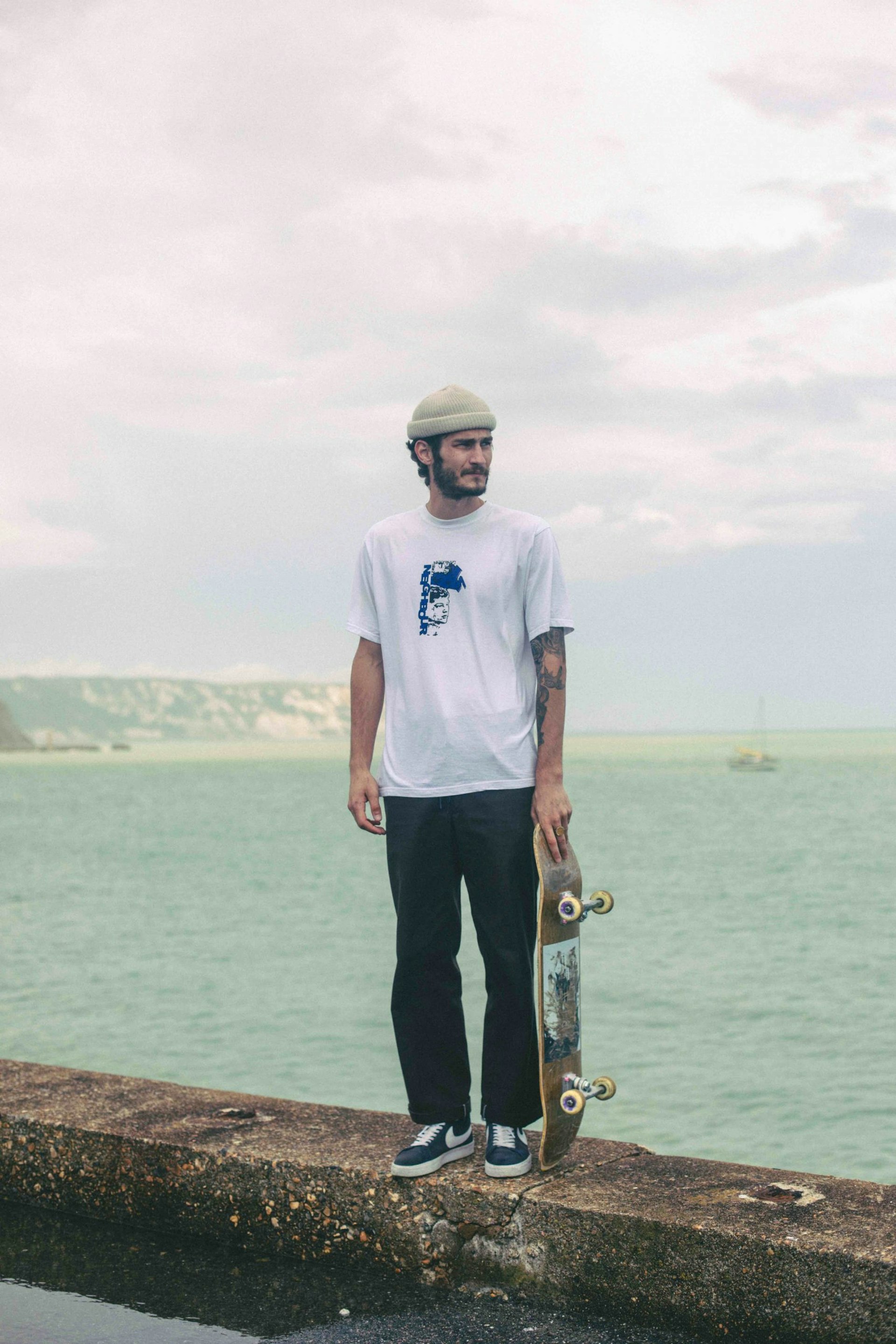 This is just the beginning of skateboarding’s 180. Following its debut at the Tokyo Olympics, the sport is set to make a second appearance in 2024 – just across the English Channel – in Paris. Right here in Folkestone, where ‘No skateboarding’ signs still line The Leas coastal path, that transformation will soon be completed with F51, the world’s first bespoke multi-storey skatepark.
This is just the beginning of skateboarding’s 180. Following its debut at the Tokyo Olympics, the sport is set to make a second appearance in 2024 – just across the English Channel – in Paris. Right here in Folkestone, where ‘No skateboarding’ signs still line The Leas coastal path, that transformation will soon be completed with F51, the world’s first bespoke multi-storey skatepark.
F51 will contain 650 square metres of skateable timber surface, suspended concrete bowls, wall rides and volcanoes, as well as a climbing wall, boxing ring and an events space. The trick organisers hope to land is for F51 to become one of the world’s great skate parks, along with the likes of Portland’s Burnside and Marseille’s Skatepark du Prado.
Guy Hollaway, whose architecture firm Hollaway Studio designed F51, says that the project was “one of the hardest” he’s ever taken on. Beset by constant delays, linked to escalating costs, the complex design and the building’s cladding, F51 was initially planned to be a multi-storey car park. Years down the line, and now on the cusp of its heavily-anticipated opening, the building’s exterior looks like the hull of a great ship: an angular metallic structure that could slot into London’s Canary Wharf district.
“I wanted a building that felt very urban,” says Hollaway. “I wanted something that gave back to the town at street level. How do you keep it cool, relevant and accessible and make sure the ownership of the building is for the people of Folkestone?”
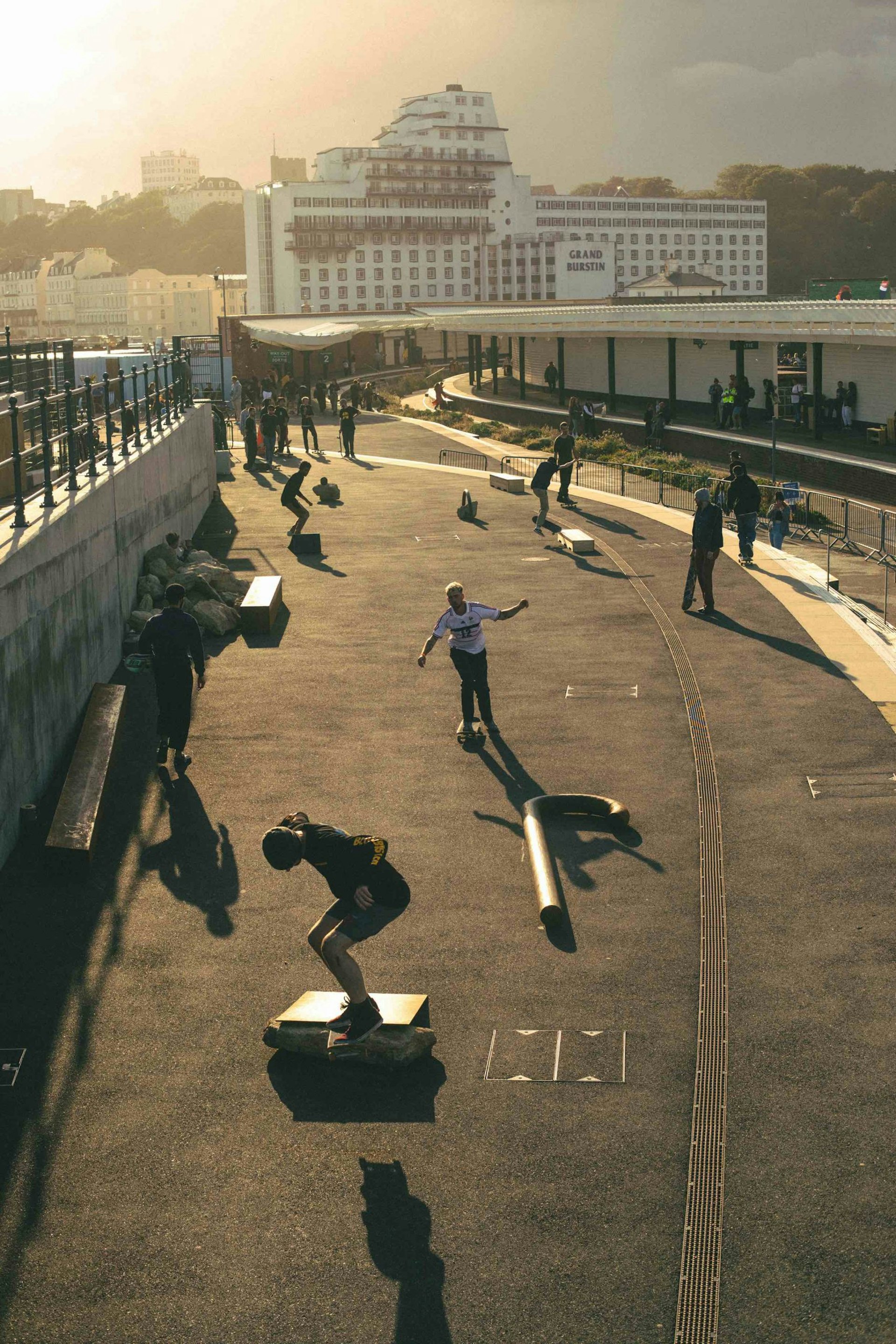 But from the inside, F51 comes into its own – and somehow appears even bigger. On the first floor, enormous concrete bowls are suspended in the air – a world first – and down in reception, where there will also be a café, the bowls dip not far above head level. “Putting that much concrete in the air, you feel the weight of those bowls over your head,” adds Hollaway. “That took a huge amount of engineering. We’re creating almost a new building type, a new way of thinking about extreme sports.”
But from the inside, F51 comes into its own – and somehow appears even bigger. On the first floor, enormous concrete bowls are suspended in the air – a world first – and down in reception, where there will also be a café, the bowls dip not far above head level. “Putting that much concrete in the air, you feel the weight of those bowls over your head,” adds Hollaway. “That took a huge amount of engineering. We’re creating almost a new building type, a new way of thinking about extreme sports.”
But F51 tells yet another tale of division. More than most towns, Folkestone is a beast with two heads; a bellwether for Brexit Britain.
Dilapidated 1960s seafront hotels, infamous for bed bugs and drug deals, are a few hundred metres from a lighthouse champagne bar on the tip of a £3.5 million refurbished part of the harbour. Even the two-headed chalk statue of Roman god Janus – installed as part of the Folkestone Triennial festival on a hillside to look both out to the European mainland and inward at the heartlands of Britain – has been lauded by critics yet vandalised by locals. In Roman mythology, Janus was the god of doors and gates – representing transition and duality.
“Tourism and that side of it has changed Folkestone so much in the last few years,” adds Lee. “It’s changed massively. Everything will get better apart from the people who live in it. Yes, F51 is going to be a world-class facility. In the future, there’s going to be an Olympic winner from F51. But I hate the Olympics, and I don’t think I’m going to be able to afford to live in a town like this in the future.”
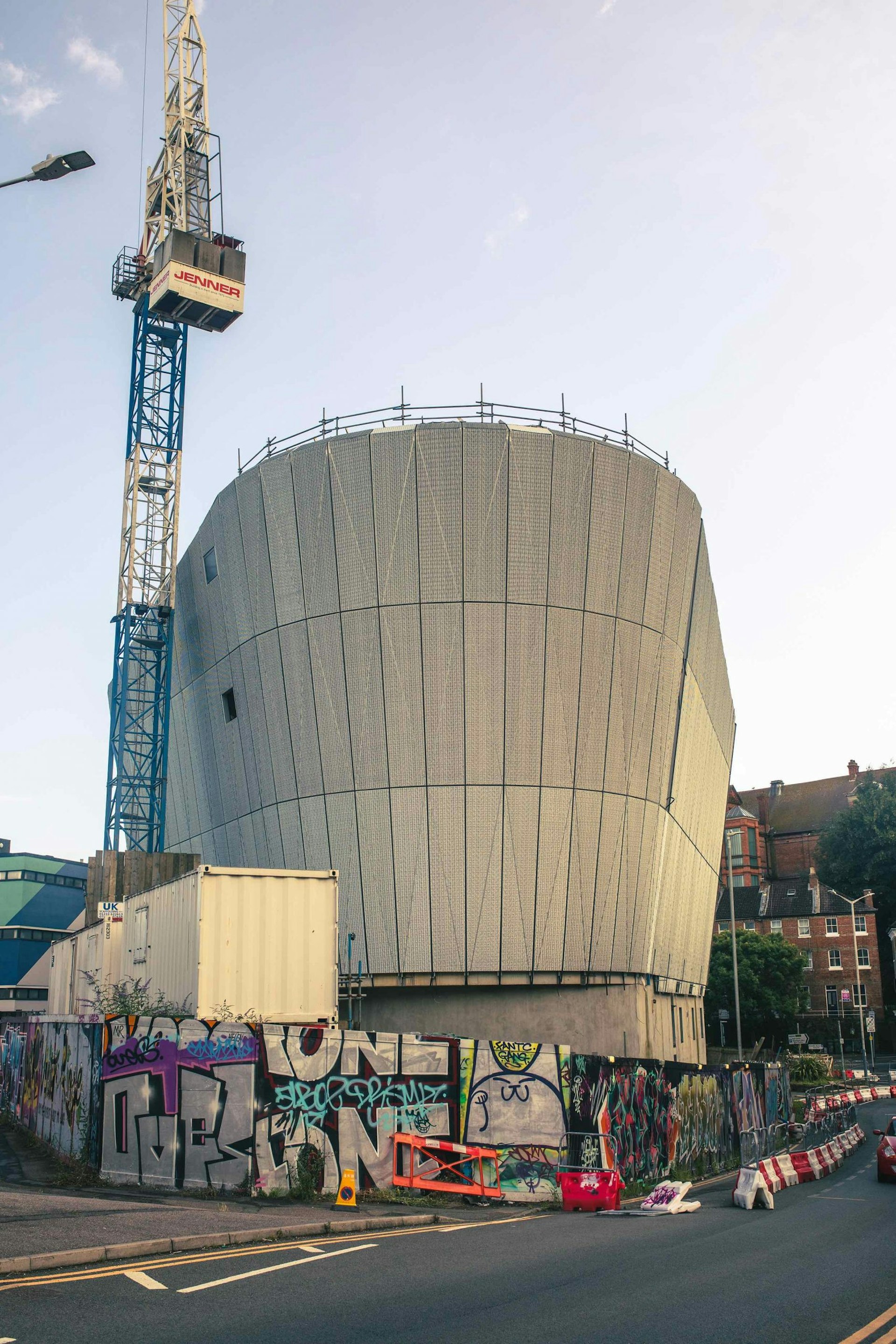 Those divisions are set to become even more stark. In an area where lorry drivers sit in endless customs queues, refugees fleeing war zones in dinghies are detained in “prison-like” facilities, and in some parts more than 50 per cent of children live in poverty, the seafront will soon be dominated by a development of 1,000 new homes, and over 10,000 square metres of commercial space.
Those divisions are set to become even more stark. In an area where lorry drivers sit in endless customs queues, refugees fleeing war zones in dinghies are detained in “prison-like” facilities, and in some parts more than 50 per cent of children live in poverty, the seafront will soon be dominated by a development of 1,000 new homes, and over 10,000 square metres of commercial space.
The mastermind of that is Roger De Haan, billionaire owner of the SAGA insurance empire and countless restaurants, pubs and properties around town. He has pumped millions into regenerating Folkestone, but locals say he has not done so without personal benefit. Folkestone’s beloved former skatepark, The Shed, once sat on the beachfront and was run as part of a community centre for a decade. But it was demolished in 2017, as De Haan began to prepare the land for development. Local skaters say there have been broken promises.
“Originally, Roger de Haan came in personally and promised that he wouldn’t get rid of The Shed until F51 was made,” says Dane Freeman, 25, who grew up in nearby Seabrook. “But that was four or five years ago. It’s been gone a long time now. A lot of us get moaned at for skating in the streets. But there was no skatepark, so the streets were all we had. Some people call the police.”
Freeman was a regular skater at The Shed after first picking up a board aged 12. Even if he was injured and unable to skate (he’s encountered his fair share of knocks over the years), he would still head down there to see the other skaters. “It didn’t matter about skating all the time, but seeing your friends and learning to love the sport and enjoy it,” he says.
 Like many others in the Folkestone scene, Freeman speaks about skateboarding as a kind of poetic catharsis. “Sometimes life can be strange and you can feel trapped and not going anywhere, but skating can show you progression,” he says. “Skateboarding is art in motion. It’s a very soulful thing. It’s my answer to everything. If I’m in a good mood: ‘Go skate.’ If I’m feeling sad: ‘Go skate.’ If I’m angry, ‘Go skate.’”
Like many others in the Folkestone scene, Freeman speaks about skateboarding as a kind of poetic catharsis. “Sometimes life can be strange and you can feel trapped and not going anywhere, but skating can show you progression,” he says. “Skateboarding is art in motion. It’s a very soulful thing. It’s my answer to everything. If I’m in a good mood: ‘Go skate.’ If I’m feeling sad: ‘Go skate.’ If I’m angry, ‘Go skate.’”
But for Freeman and many others, the threat to Folkestone’s skating spaces is a threat to this unique freedom – one that they believe the heavily commercialised F51 won’t provide. That threat, once again deriving from pressure to develop land, is rearing its head a few miles along the coast from the town centre.
Sandy Lanes, a historic maze of dirt tracks dug into a hillside, has for years been used by longboarders and BMXers alike. “There’s been mad jams here,” says Max Ready, a 27-year-old fibre optics engineer who has frequented the area since he was a boy, just as his dad once did. “It’s been there since forever. When I’ve had hard times, it’s so relaxing and peaceful. I have so many memories. It’s like the Wild West. Anything goes in Sandys. It’s one of the last places you can still go and do what you want.”
Despite being a local, Ready no longer goes to Folkestone town centre. The way the place has transformed and gentrified since the High Speed rail line from Ashford was built, not to mention the destruction of The Shed, has left Ready and his friends feeling disillusioned.
 But even though Ready has tried his best to avoid them, those societal changes are inching ever, inescapably closer. In the summer, housing developers flattened huge parts of the tracks at Sandy Lanes.
But even though Ready has tried his best to avoid them, those societal changes are inching ever, inescapably closer. In the summer, housing developers flattened huge parts of the tracks at Sandy Lanes.
“Folkestone was definitely rougher, it wasn’t as nice a place [before the changes began],” he adds. “But as kids, it was fun. This [redevelopment] just feels like the rich are getting richer. It’s an excuse if you can pillage and plunder everything. It’s not really helping the Folkestone people. People are struggling to get jobs and housing.”
The impact of regeneration in Folkestone is not black and white – more a deep grey like today’s Kentish sky. Not all skaters or locals are opposed. Far from it. F51 has brought “much more acceptance” to skating according to Freeman. “It’s much easier for people to appreciate us,” he says. “Now it’s in the Olympics, it’s been identified as a respectable sport rather than the old idea that skateboarding is a crime.”
Freeman also believes the town’s redevelopment has helped to improve the lives of locals – his stepdad, for example, is helping to construct De Haan’s waterfront apartments. “The poorer areas are slowly starting to be helped,” he says.
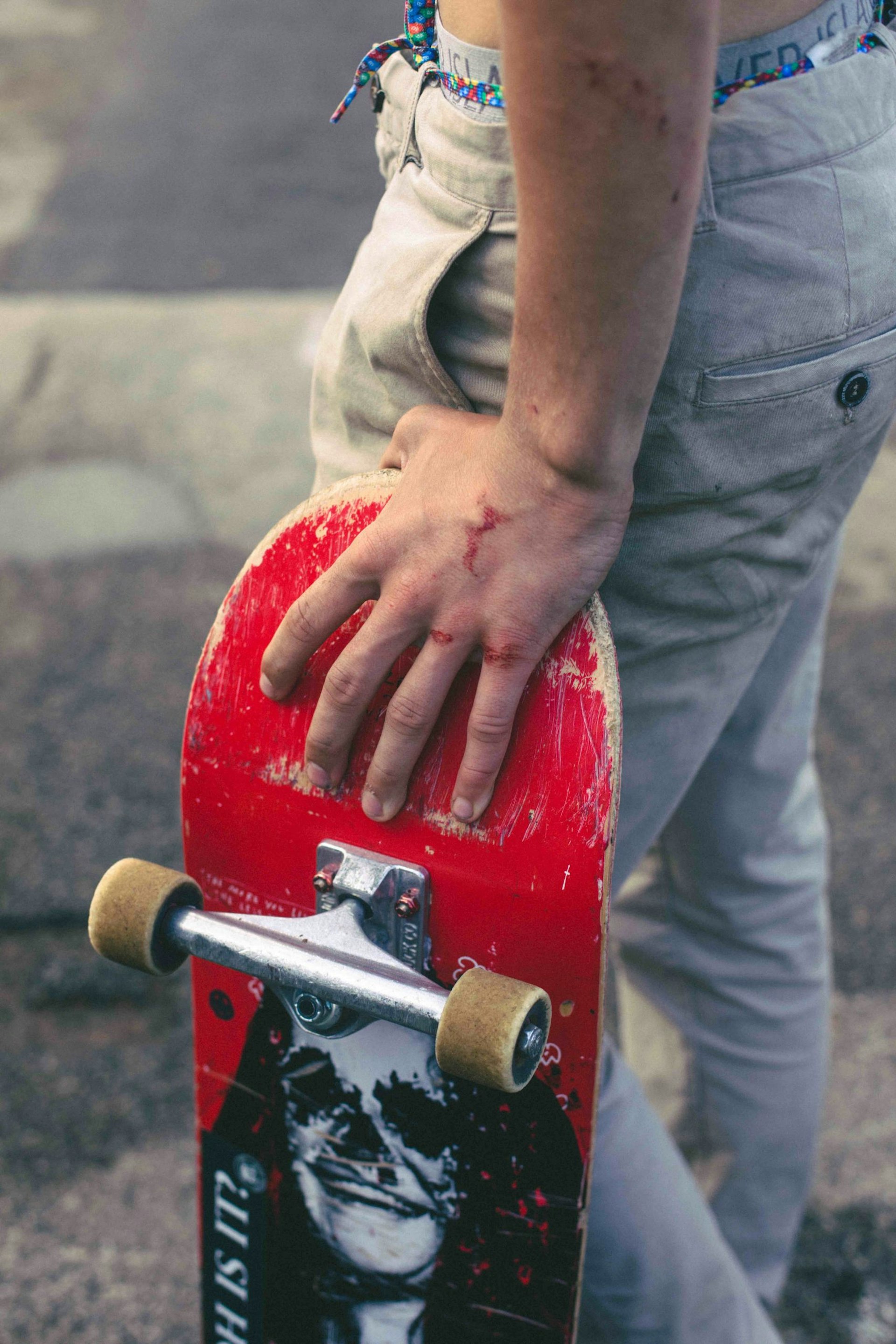 Laurence Hickmott, chief executive of Shepway Sports Trust, the organisation that is running F51, insists that F51 will be for locals. “We hope skaters will visit us from all over the country and further afield and we are in talks with Team GB about hosting training programs,” he says. “But this building has been built first and foremost for the local community. We want it to be a community hub.”
Laurence Hickmott, chief executive of Shepway Sports Trust, the organisation that is running F51, insists that F51 will be for locals. “We hope skaters will visit us from all over the country and further afield and we are in talks with Team GB about hosting training programs,” he says. “But this building has been built first and foremost for the local community. We want it to be a community hub.”
Hickmott says that although prices have not yet been announced, subsidised rates will be available for locals. “The facility is going to be very much about inclusivity and making people feel welcome,” he adds. “We believe that people can come together, no matter where you’re from. Skate together, play together, whatever it is.”
Whether that is corporate-speak to appease critics or part of a genuine effort to transform life in Folkestone will, as ever, divide opinion. Even with the opening of F51, some believe they need to take matters into their own hands. Ready and his friends at Sandy Lanes say they have a better plan for helping Folkestone’s local community: they want to band together to buy the land and open up a site with a bike park, café, camping facilities and family areas. Only then can they guarantee their own future and the community’s right to the land.
“We’ve got so many ideas,” says Ready. “We don’t want all these rules and regulations. We don’t want these profit margins. We just want the freedom to do what we want.”
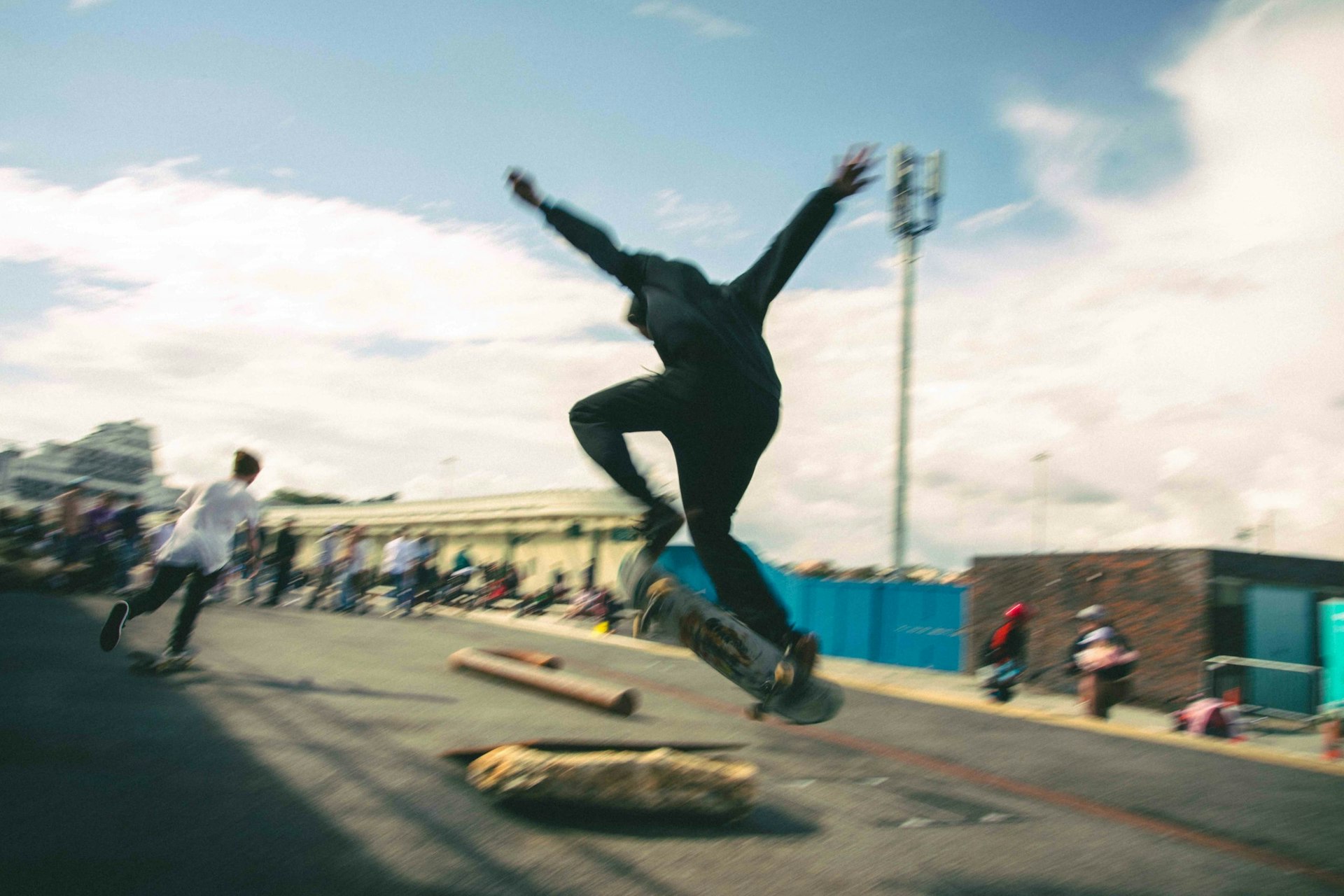 A version of this story appears in Huck Issue 76. Get your copy now, or subscribe to make sure you never miss another issue.
A version of this story appears in Huck Issue 76. Get your copy now, or subscribe to make sure you never miss another issue.
Follow Peter Yeung on Twitter.
Enjoyed this article? Like Huck on Facebook or follow us on Twitter.
